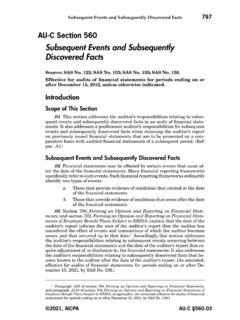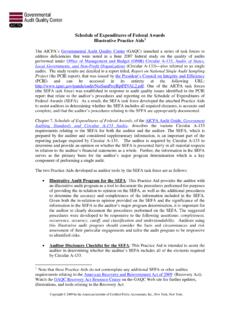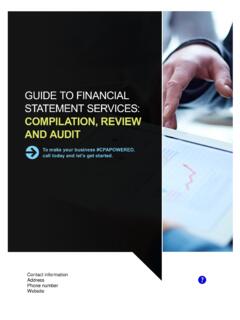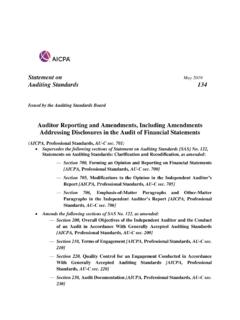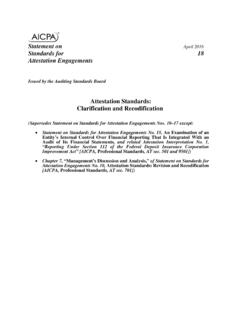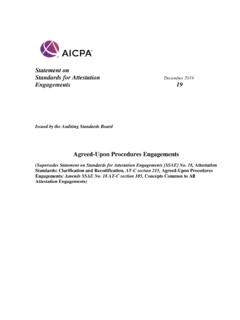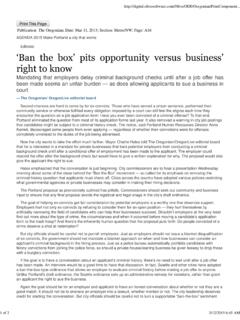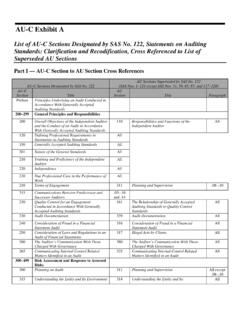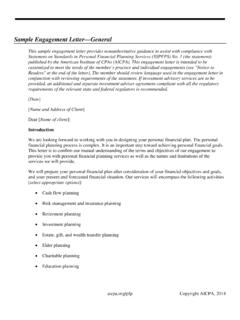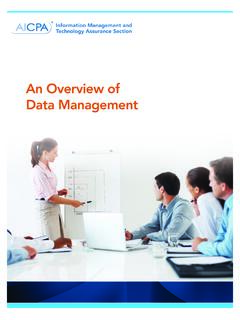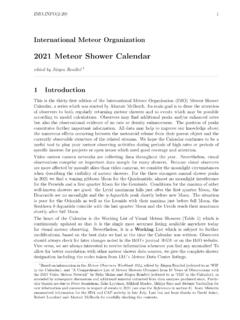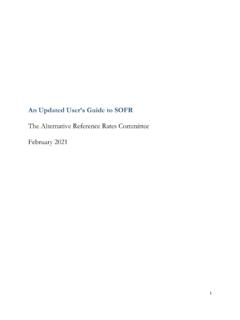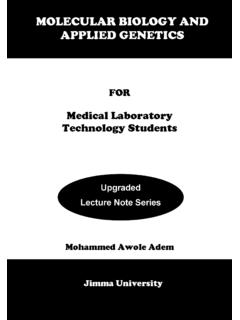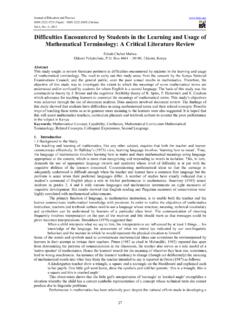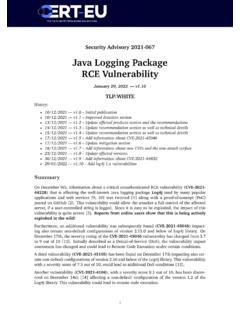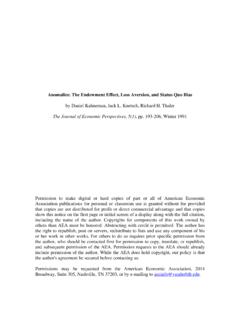Transcription of Omnibus Statement on Auditing Standards 2019
1 Page 1 of 36 Statement on May 2019 Auditing Standards 135 Issued by the Auditing Standards Board Omnibus Statement on Auditing Standards 2019 (Amendments to Statement on Auditing Standards (SAS) No. 122, Statements on Auditing Standards : Clarification and Recodification, as amended, o section 210, Terms of Engagement; o section 240, Consideration of Fraud in a Financial Statement Audit; o section 260, The Auditor s Communication With Those Charged With Governance; o section 265, Communicating Internal Control Deficiencies Identified in an Audit; o section 315, Understanding the Entity and Its Environment and Assessing the Risks of Material Misstatement; o section 330, Performing Audit Procedures in Responses to Assessed Risks and Evaluating the Audit Evidence Obtained; o section 510, Opening Balances Initial Audit Engagements, Including Reaudit Engagements; o section 550, Related Parties; o section 560, Subsequent Events and Subsequently Discovered Facts; Section 580, Written Representations.)
2 O section 600, Special Considerations Audits of Group Financial Statements (Including the Work of Component Auditors), and o section 930, Interim Financial Information [AICPA, Professional Standards ]; SAS No. 130, An Audit of Internal Control Over Financial Reporting That Is Integrated With an Audit of Financial Statements [AICPA, Professional Standards , AU-C sec. 940]) Page 2 of 36 Copyright 2019 by American Institute of Certified Public Accountants, Inc. New York, NY 10036-8775 All rights reserved. For information about the procedure for requesting permission to make copies of any part of this work, please e-mail with your request. Otherwise, requests should be written and mailed to the Permissions Department, AICPA, 220 Leigh Farm Road, Durham, NC 27707-8110. 1 2 3 4 5 6 7 8 9 0 AudS 1 9 8 7 6 5 4 3 Page 3 of 36 Statement on Auditing Standards Omnibus Statement on Auditing Standards 2019 Boldface italic denotes new language.
3 Deleted text is in strikethrough. Amendment to SAS No. 122, Section 260 1. AU-C section 260, The Auditor s Communication With Those Charged With Governance, addresses the auditor s responsibility to communicate with those charged with governance in an audit of financial statements. This amendment adds material from PCAOB AS 1301 that the ASB believes will enhance the quality of audits of financial statements of non-issuers. Additional communications about the auditor s views relating to the entity s significant unusual transactions, and about the potential effects of uncorrected misstatements on future-period financial statements are required. Application material provides guidance about communicating the possible implications of uncorrected misstatements and complaints or concerns about accounting or Auditing matters that have come to the auditor s attention. Additionally, application material is provided addressing documentation when management has communicated some or all of the matters the auditor is required to communicate with those charged with governance.
4 [No amendment to paragraphs .01 .11.] .12 The auditor should communicate with those charged with governance: (Ref: par..A25 .A26) a. The auditor s views about qualitative aspects of the entity s significant accounting practices, including accounting policies, accounting estimates, and financial Statement disclosures. When applicable, the auditor should (Ref: par..A27 .A29) i. explain to those charged with governance why the auditor considers a significant accounting practice that is acceptable under the applicable financial reporting framework not to be most appropriate to the particular circumstances of the entity. ii. determine that those charged with governance are informed about the process used by management in formulating particularly sensitive accounting estimates, including fair value estimates, and about the basis for the auditor's conclusions regarding the reasonableness of those estimates.
5 B. Significant unusual transactions, if any. (Ref: par..A30) Page 4 of 36 bc. Significant difficulties, if any, encountered during the audit. (Ref: par..A30A31) cd. Disagreements with management, if any. (Ref: par..A31A32) de. Circumstances that affect the form and content of the auditor s report, if any. (Ref: par.. ) f. Matters that are difficult or contentious for which the auditor consulted outside the engagement team and that are, in the auditor s professional judgment, significant and relevant to those charged with governance regarding their responsibility to oversee the financial reporting process. g. Other findings or issues, if any, arising during the audit that are, in the auditor s professional judgment, significant and relevant to those charged with governance regarding their responsibility to oversee the financial reporting process. (Ref: par.)
6 Uncorrected Misstatements .13 The auditor should communicate with those charged with governance: (Ref: par.. ) a. uncorrected misstatements accumulated by the auditor and the effect that they, individually or in the aggregate, may have on the opinion in the auditor s report. The auditor s communication should identify material uncorrected misstatements individually. The auditor should request that uncorrected misstatements be corrected. b. the effect of uncorrected misstatements related to prior periods on the relevant classes of transactions, account balances or disclosures, and the financial statements as a whole. c. that uncorrected misstatements or matters underlying those uncorrected misstatements could potentially cause future-period financial statements to be materially misstated, even if the auditor has concluded that the uncorrected misstatements are immaterial to the financial statements under audit.
7 [No amendment to paragraphs .14 .15.] Forms of Communication 17. If, as part of its communication to those charged with governance, management communicated some or all of the matters the auditor is required to communicate, and as a result, the auditor did not communicate these matters at the same level of detail as management, the auditor should communicate any omitted or inadequately described matters to those charged with governance. The auditor does not need to communicate them at the same level of detail as management, as long as the auditor a) participated in management s discussion with those charged with governance, and b) affirmatively confirmed to those charged with governance that management has adequately communicated these matters. Page 5 of 36 [Paragraphs .17 .19 are renumbered as .18 .20. The content is unchanged.] Documentation .2021 When matters required to be communicated by this section have been communicated orally, the auditor should include them in the audit documentation, including when and to whom they were communicated.
8 Fn 2 When matters have been communicated in writing, the auditor should retain a copy of the communication as part of the audit documentation. If, as part of its communication to those charged with governance, management communicated some or all of the matters the auditor is required to communicate, and as a result, the auditor did not communicate these matters at the same level of detail as management, the auditor should include a copy or summary of management s communications provided to those charged with governance in the audit documentation. (Ref: par..A47A48) [No amendment to paragraphs .A1 .A29.] Significant Unusual Transactions (Ref. par..12b) .A30 The communication of significant unusual transactions may include the auditor s views on the policies and practices management used to account for significant unusual transactions; and the auditor's understanding of the business purpose for significant unusual transactions.
9 [Paragraphs .A30 .A57 are renumbered as .A31 .A58. The content is unchanged.] This amendment is effective for audits of financial statements for periods ending on or after December 15, 2020. Amendment to SAS No. 122, AU-C section 550 2. AU-C section 550, Related Parties, addresses the auditor s responsibility relating to related party relationships and transactions in an audit of financial statements. This amendment adds material from PCAOB AS 2410, Related Parties, that the ASB believes will enhance the quality of audits of financial statements of non-issuers. The amendment adds or amends fn 2 Paragraphs .08 .12 and .A8 of section 230, Audit Documentation. Page 6 of 36 requirements and application material to heighten the auditor s focus on related parties relationships and transactions. The amendment accomplishes the following: Enhance requirements to identify previously unidentified or undisclosed related parties or significant related party transactions.
10 Enhance the auditor s response to the risks of material misstatement associated with related party relationships and transactions, including procedures to test the accuracy and completeness of the related party relationships and transactions identified by the entity, taking into account the information gathered during the audit. Provide application material regarding the enhanced requirements, as well as additional examples of significant related party findings and issues that may be communicated to those charged with governance..01 This section addresses the auditor s responsibilities relating to related party relationships and transactions in an audit of financial Specifically, it expands on how section 315, Understanding the Entity and Its Environment and Assessing the Risks of Material Misstatement; section 330, Performing Audit Procedures in Response to Assessed Risks and Evaluating the Audit Evidence Obtained; and section 240, Consideration of Fraud in a Financial Statement Audit, are to be applied regarding risks of material misstatement associated with related party relationships and transactions.
